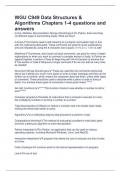Exam (elaborations)
WGU C949 Data Structures & Algorithms Chapters 1-4 questions and answers
- Course
- Institution
WGU C949 Data Structures & Algorithms Chapters 1-4 questions and answers In-line, Multiline, Documentation Strings (Docstrings)In Python, there are three (3) different types of commenting styles. What are they? In-line"Comments used to add meaning to a program and explain logic in-line...
[Show more]



